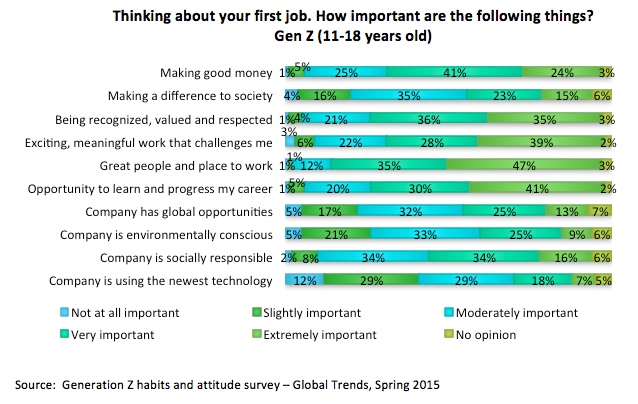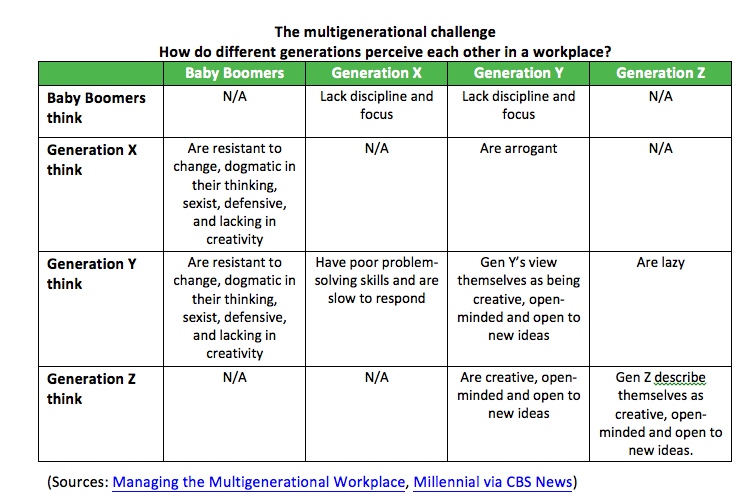May 2015: Like all of us, the next generations Gen Y (typically defined as 1980 to 1994) and Gen Z (typically defined as 1995 – 2009), are shaped by their times. Generation Y is the first transformational generation. They have grown up in a radically different world from that of their parents, surrounded by modern technologies and a society of consumerism – and it shows in the way they live, work, play, and consume. While some of Generation Y may vaguely remember a world with only limited technology, today’s teenagers, Generation Z, have never experienced a world without it. Technology is in the DNA of these “next” generations, probably the single most important difference versus the generations before them.
For today’s digital generations, flexibility, mobility, and immediacy are king. Their attitudes and behaviors are permeating every facet of life and work, embracing the virtual, living in real time. They are coexisting with, if not thriving on, social networking, the cloud, and cyberspace demands that are often seen as overwhelming by many older people. An increasing move towards flexible and mobile ways of working is one result, as the younger generations challenge conventional and stationary working patterns and management methods – but their impact will be much broader.

In a world seeking scarce talent it is critical that organizations understand the mindsets, traits, desires, and styles of the next generations on their payrolls if they are to make the most of the contributions of all staff. Managing the balance in serving and employing different generations will not be easy, but will become increasingly important. Today, many organizations are ill-prepared to do so because leaders and managers have been trained to think and respond to a very different business environment that the one they already face today and will increasingly face in the future.
In this briefing we look at how businesses and organizations can attract, retain and challenge these next generations in a workplace to make the most of their talent overall.
Tapping into the next generations of talent
Many industries are already facing gaps in critical skills, so now is the time to rethink how to recruit and attract new generations to fill out future talent pipelines. Today, many employers are still struggling to find the best ways to attract and retain the much talked-about Gen Y. Yet, within a decade or so the workforce will be flooded not only with Gen Y but also with their successors, Gen Z. While the next two new generations entering the workforce have both grown up in a world shaped by technology, it is important to note that their mindsets differ in many ways – and that what attracts Gen Y may not be the same as what attracts Gen Z, as the examples below suggest.
Looking for at job? According to a survey from Center for Executive Education, job openings need to be advertised on more than corporate websites. But organizations must remember that, when looking for career opportunities, Gen Y prefers online job boards (61.31%) whereas Gen Z prefers social networking (69.9%) and recruitment/staffing firms (73.79%). In considering a prospective employer Gen Z seem to be less interested in large corporate organizations, while Gen Y shows no real preference about company size. (Source: Randstad/Millennial Branding)
Technology matters: Keeping up with new technology is critical. Both generations are constantly connected and communicating.Gen Y grew up with computers, embracing new technologies as they became more sophisticated and available. Gen Z, on the other hand, was born into a digital world, the first truly digital native generation. For them, a world without touchscreens, intuitive gaming devices, mobile phones and communication apps is simply unthinkable. Technology is a must in their prospective workplace as both generations rely heavily on IT and communications to source information, develop skills and collaborate. However, a majority of both Gen Y and Gen Z do actually prefer face-to-face communication with managers in a workplace. (Source: Randstad/Millennial Branding)
Make room for compulsive multitaskers: Because the next generationshave been raised on the internet and with information constantly available via multiple devices, digital immersion is shaping their brains in ways never seen before. Gone are the days when learning demanded we task our brains with huge amounts of memorization. Today’s tech-savvy generations are demonstrating cognitive agility and abilities to multitask that are changing how we learn and work. They are not only able to switch between mentally challenging tasks rapidly, but also able to semi-focus on many things at once. In short, their brains are developing differently to those of generations that grew up without the same access to technology. It is therefore critical that organizations recognize and accept that younger generations may choose non-traditional ways to solve tasks, pay attention and take responsibility. (Source: Fortune)
Be responsible – socially and environmentally? The global future talent survey from Nielsen reveals that young people between 18 and 34 years old are focused on “doing good” in their work. 70% prefer to work for a company committed to positive social and environmental impact. This is even more important to those in emerging markets (77%) than it is for those in developed markets (67%). However, it doesn’t stop there as corporate social responsibility (CSR) factors not only into where job candidates choose to apply for work but also whether or not they choose to do business with a company. A report from Sparks & Honey reveals that Gen Z are determined to “make a difference” and “make an impact”. Social entrepreneurship is one of the most popular career choices.
Diversity matters – looking global and beyond homogeneity: Throughout the years Gen X has become more accepting and open-minded towards global, multi-generational and multi-cultural environments. Even while Gen X embraces diversity, Gen Y and Gen Z are more demanding, expecting their future employers to be inclusive of all generations, races, cultures and academics. These generations celebrate diversity and believe it is a learning opportunity and a way to cross boundaries. They expect to be surrounded by difference.
Making the most of the next generations at work
With scarcity of talent top of mind for many organizations, once they have attracted people, it is critical that they manage their newfound talent carefully. Younger generations are likely to be much more impatient with managers and other employees if they are not recognized for whom they are and what they do. To retain and manage them it is critical to provide the right opportunities at the right time and to engage them effectively so that they don’t feel tempted to jump over to competitors or other opportunities.
However, employers also need to recognize that long-term job security doesn’t exist in the dictionary of younger generations, who see moving jobs during their career as not only natural but necessary to realize their potential and ambitions. Gen Y is expected to switch employer at least five times throughout their career while Gen Z is expected to switch at least four times. A career in its traditional form doesn’t apply to them. It will more likely look like crawling around a spider web than climbing the corporate ladder.
9 to 5 – No thanks! The next generations want to “work hard – play hard” on their terms. Surrounded by technology, crowdfunding and crowdsourcing they dream of being entrepreneurs, starting their own business or just working as freelancers. 38% of Gen Y is freelancing compared to 32% of all others. These young people are have an entrepreneurial mindset, with creativity, freedom and flexibility being important drivers for careers. It is not that they are lazy but the 9-5 grind is over. For those wanting to work for an organization expectations are that an independent work environment, work/life balance and flexibility are a part of the package. Only 11% want regular corporate office hours while 89% prefer to work when/where they chose. (Sources: Fast Company, ODesk/Millenial Branding). Could contingent employment be the future alternative to the traditional employer/employee relationship?
Motivate ME: Gen Y grew up with their Baby Boomer parents providing constant appraisal and feedback while Gen Z is growing up in a gaming world filled with instant feedback and rewards. Providing feedback, instant gratification and recognition, social environments, fun cultures and the opportunity to work with other bright and creative people are ways to motivate and make these next generations of workers feel purposeful. However, a recent survey from Randstad/Millennial Branding reveals that, contrary to earlier research, Gen Y now prioritizes money over meaningful work. The reason: The state of the economy combined with student loan debts. Today 38% of Gen Y is primarily motivated by more money while 34% of Gen Z is most motivated by opportunities for advancement. “Meaningful work” now takes a back seat to money for both generations globally.
Make room for progress: Gen Z is still shaping their thoughts about future careers and little is written about their aspirations as yet. Both generations are labelled job-hoppers but it doesn’t mean that they don’t want a career. They are job-hoppers focused on career progression, training and development. As a result, organizations need to focus on developing staff retention plans that include continuous training and development since 79% of Gen Y’s have career growth/advancement as their primary concern. Job-hopping could well be reduced if they provide the right opportunities for these young people to excel. Center for Executive Education)
Transparency is a must: Traditional management models tend to keep information at the top and limit information to a “need to know” basis, where controlling information between departments, teams and units is often used as a tool to promote internal competition. These rules will not work for the next generations of workers for whom information overload doesn’t exist and “I don’t know” just means they haven’t looked it up on the internet or tapped into their social network yet. They don’t know what it is like not to have an enormous amount of information and choices when making decisions. These young people who have grown up in an open-source environment will expect information and transparency in the workplace in order to innovate and to make better decisions. (Source: When Millennials take over)
Don’t manage ME – Mentor ME: Modern times call for modern management. Rather than command and control management methods or micro-management, coaching, mentoring and peer learning are likely to be more appropriate management tools for Gen Y and Gen Z. They are looking for flat management structures and a supportive style of management that allow them independence and responsibility early in their careers. A Center for Executive Education survey suggests that 95% of Gen Z and 85% of Gen Y cited their ideal manager as a coach or mentor figure. They also expect their leaders to be effective communicators and good listeners. Managers should be authentic and lead from the front and by example or adopt servant leadership, instead of a commanding or directive style.
Leading a multigenerational organization
The oldest members of Gen Z are starting to land their first jobs and, for the first time ever, five distinct generations are present in the workforce in many economies – highlighting differences in generational ambitions, attitudes, technology skills, and ethics that are impacting management styles and how work is done.
The collision of more generations in a workplace – unless their mindsets and expectations are carefully managed – could potentially lead to long-term turbulence. To overcome this threat, leaders need to accept that one size doesn’t fit all in leading a multigenerational workforce, a challenge for which too few organizations are prepared.

No doubt that there are differences among generations. However emerging research suggests that the differences are slightly overstated and can effectively being addressed and leveraged leading to a stronger organization and bottom line if managed the right way.
Examples of companies actively managing multigenerational differences
General Mills: Years ago General Mills invented a board game called “Leading Through the Generations” to teach employees about work and communication styles in different generations. The purpose of the game was to open up a dialogue among co-workers and help them to understand people that have different methods to get work done. (Source: The Multi-Generational Workforce)
Ernst &Young:For some years, Ernst & Young has held workshops to help foster understanding and teamwork among its multi-generational workforce. These focus on developing leadership skills across generations and tapping into “emotional intelligence” to better understand the underlying values of each generation. (Source: The Multi-Generational Workforce)
Dell: In 2009, Dell began discussions about multi-generational differences in the workplace. Today, Dell is focusing on making its organization attractive to all generations. It works with an ecosystem that incorporates the needs, desires and wishes of all generations, not only younger generations. New leaders must take a course that includes leading multigenerational teams and connecting with the people who report to you. Another initiative, “Connected Workplace,” encourages employees to participate in discussions with leaders about “new ways to think about where and how work gets done,” including opportunities to work remotely and telecommute. (Sources: The Multi-Generational Workforce, Human Resource Executive Online)
Scripps Health in San Diego: Since 2001 the company has followed a system-wide strategic plan not just to address workforce development, but to attract and retain employees from all generations. This plan was developed to counteract high turnover, labor shortages, and broken communications channels. To implement it, Scripps Health trained all leaders about different communication styles, studied what motivated and demotivated different workers, and committed to specific leadership goals and strategies around multigenerational diversity. (Source: Best practices: Four keys to successfully managing a multigenerational workforce)
Vox Mobile: The founder and CEO of Vox Mobile in Cleveland, Ohio has realized that one-size do not fit all. Generational needs are different and therefore he is motivating his employees with incentive that mean something to them. He says. “There are no hard and fast rules, but generally speaking, my Gen Y workers want us to fund their LinkedIn accounts; they like things like branded gear and company-sponsored happy hours — they’re more social and they’re not going home right after work. Gen Xers don’t care about logoed backpacks; instead they are looking at our 401(k) matching plan and our healthcare provisions.” (Source: HBR)
In June: Look out for trends in action on Navigating tomorrow’s digital landscape




